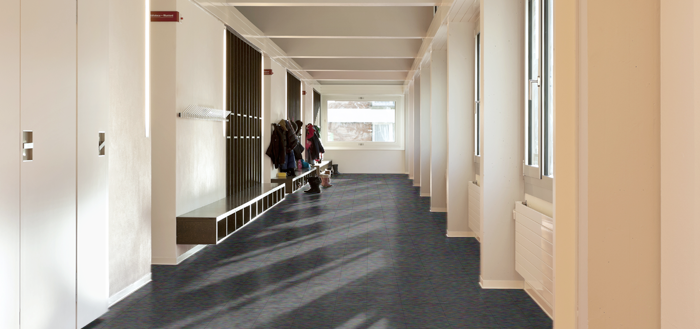By: Briana Smith, Social Media & Product Branding Specialist, WAXIE Sanitary Supply

Unless your facility has been built sometime in the last 20 years or so, there is a good probably that your flooring is either some form of asbestos or asphalt tile. These tiles were a type of vinyl composition tiles (VCT), which were used predominately between the 1920s through to the early 1980s. At the beginning of the 1980s, modern non-asbestos containing vinyl composition tiles became standard, as asbestos related materials – including adhesives & mastics that had asbestos in them – were recognized as being hazardous by the EPA.
Modern VCT tiles are designed in a different manner, as they are produced from a mixture of colored polyvinyl chloride (PVC) chips, and are often made to resemble high-end flooring materials such as stone, wood, etc. without the cost. VCT is still a very popular flooring material as it holds up well in busy high-traffic areas, has a long lifespan and is much less expensive than high-end flooring options.
What is the difference between asphalt & asbestos tiles?
Asbestos and asphalt tiles were actually used during much of the same time periods, with asphalt tiles predating asbestos tiles, but they varied not only in asbestos composition, but in binding materials. They were originally a by-product of asbestos mining, and came into existance as a result of experiments in asphalt roofing material technology.
Asphalt Tile (asphalt-asbestos tile): Is a type of tile that contains asbestos used predominately between the 1920s-1960s. Often tiles were of 9"x9" size (pre-1960) and 12"x12" (post-1960) and typically produced in dark colors (black & dark gray) as asphalt was the main binder. Brown asphalt tiles were also produced, and contained a fair amount of asphalt in them, but they used gilsonite as a binder. Asphalt tiles could contain as much as 70% asbestos (by weight) in them depending on the brand and material composition.
Asbestos Tile (vinyl-asbestos tile): Is another type of tile that contains asbestos popular between the 1930s-1970s, which used resin vinyl as the binder, allowing for lighter colored tiles to be produced: pink, green, cream, blue, etc. Tiles sizes were pretty much the same as the asphalt ones: 9"x9" size (pre-1960) and 12"x12" (post-1960). Asbestos tiles were also significantly lighter than the asphalt ones.
There’s really only one way that you can tell if your floor tiles have asbestos in them
And that is to get your tile flooring professionally tested. If you’re looking for a general guide on identifying asbestos-based flooring, The Encyclopedia of Building & Environmental Inspection, Testing, Diagnosis and Repair is a FANTASTIC resource. The site contains historical background information, photo samples, and other helpful details about many types of flooring materials, as well as some flooring brand names, that will at minimum offer indications of whether you should get your tiles tested or not.
Please Note: A common misconception is that all of the VCT tiles produced in these eras contain asbestos, when in fact some brands did not use asbestos in their product lines (1950s-1980s) at all.
What to do if you have either asphalt or asbestos tiles
The best option is to keep it intact. Neither asphalt or asbestos tiles pose a problem unless they are broken, in which case the asbestos fibers in the tiles become airborne. To protect the tile from being damaged, you should encapsulate or seal the tile, which creates an extra barrier against chipping, scuffing and breaking. When cleaning your flooring, make sure that you never buff or sand the floors, as that will likely cause those fibers to become airborne. Also, never use a floor stripper or a high PH or butyl-based cleaning product; these types of cleaners will cause the surface of the tile to melt, cause discoloration and bleeding, as well as loss of gloss.
If you are ever concerned about your tiles, contact a local company that handles asphalt & asbestos tile remediation. They will be able to give you the best advice and can help you remove the tiles if needed. Remember, many cities & manicipalities may have a fee for removal due to the hazardous nature of the asbestos material.
If you have questions involving how to clean asphalt or asbestos tile flooring or any general care & maintenance of your flooring surfaces, contact your WAXIE Sanitary Maintenance Consultant or your local WAXIE. Our staff of industry professionals can come out to your facility and work with you to determine the best floor maintenance program & procedures to fit your needs. We’ll even help you train your staff. Get started today!
Read More:
Clean Link – The Tribulations and Trials of Stripping Asphalt Tile
Cleaning, Maintaining and Encapsulating Asbestos Tile
Encyclopedia of Building & Environmental Inspection, Testing, Diagnosis and Repair – Age of the Building
Encyclopedia of Building & Environmental Inspection, Testing, Diagnosis and Repair – Identifying Asbestos Floor Tile
Wikipedia – Vinyl Composition Tile (VCT)


